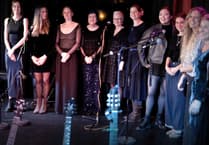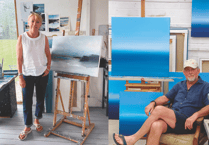TATE St Ives will present a major exhibition of the work of Lithuanian-born artist Emilija Škarnulyte this winter.
Working between documentary and the imaginary, Škarnulyte creates films and immersive installations that explore deep time and invisible systems, as well as power structures hidden within the cosmic and geological order.
In her explorations of climate change, nuclear energy, fantasy, folklore and mythology, Škarnulyte’s work covers the poetic, personal and political.
From the perspective of a ‘future archaeologist’, Škarnulyte traverses spaces that we do not readily see, such as Cold War military bases, mining sites, neutrino observatories, decommissioned power plants and deep-sea data storage units.
She reveals them to Tate St Ives as relics of a lost human culture, in which technological advancements have wrought a complex future laden with environmental harm and human losses.
At times, Škarnulyte positions herself in some of her films as a hybrid, almost mythical creature, swimming through various bodies of water.
In a deeply personal film, Aldona (2013), visitors follow Škarnulyte’s grandmother Aldona on her daily walk through Grutas Park, a sculpture garden of Soviet-era statues in southwest Lithuania, as she touches the sculptures, tracing the past and present.
In the spring of 1986, Aldona lost her vision and became permanently blind. Doctors claimed that the nerves in her eyes had been poisoned, most likely due to the explosion of the Chernobyl nuclear power plant.
Æqualia (2023) is the third in a trilogy of recent films of an imagined pantheon of feminine deities. Filmed in various confluences of rivers, they are places historically used as centres for extraction.
In it, Škarnulyte embodies a vision of a post-human chimera – part pink-river dolphin, part-siren – swimming through the waters of the Amazon Basin.
Škarnulyte glides through the six-kilometre confluence where the Rio Solimoes; milky white with suspended silts and clays from the high Andes, meets the Rio Negro; murky, black and heavy with the decay of lowland forests.
The confluence, and the sight of the imagined creature mirroring its movements, infer the complexity of what is real; the past, present and future swirl of myth, the destructive forces of capital on the ecology of the region, and what lies beneath the profundity of time.
Škarnulyte spent the month of June 2025 at Porthmeor Studios in St Ives, as part of a Tate St Ives artist residency programme, where she worked on a new 16mm film, Telstar (2025).
Drawing on the large number of fabled and ancient locations in Cornwall, she visited the Dry Tree, a standing stone near Goonhilly Downs, the ‘Cornish Pyramid’ in St Austell, Mên-an-Tol, the Boskednan Stone Circle and Chun Quoit, as well as the Goonhilly Satellite Earth Station; taking her across a spectrum of time from the Neolithic Period to the space age.
This exhibition at Tate St Ives, which runs from December 6 until April 2026, will present Škarnulytė’s work in large-scale immersive environments.
The architectural structures in the gallery will invite visitors to view the films from a series of different perspectives and at different scales, from the macro to the micro, alongside glass sculptures and lightboxes, showcasing the breadth of Škarnulyte’s practice, and bringing to the fore her visions of how mythology and technology can form a vibrant and transcendental force.





Comments
This article has no comments yet. Be the first to leave a comment.